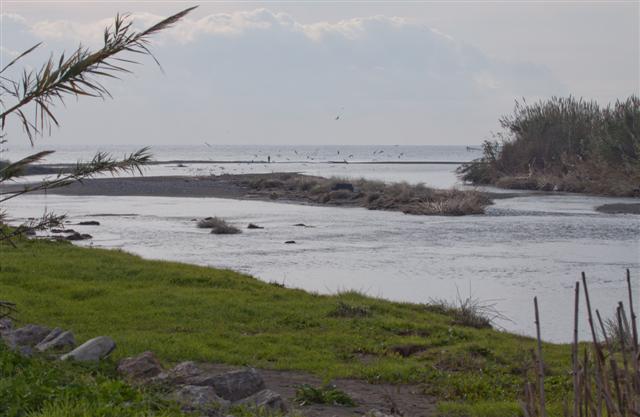Now back at Casa Collado and decided that I ought to take a look at the local birding patch so took myself off down to the Rio Velez in Torre del Mar for the morning. Morning? An hour would have been plenty of time.
.jpg) |
| The new extended lagoon with side arms at the Rio Velez, Torre del Mar |
As for the lagoon, what lagoon? The water coming downstream and has both
washed away and scoured the banks on either side so removing all the bushes and
wild shrubs from the meadow. At the same
time, having reached the town-side bank, all the vegetation has been torn out
along with much of the bamboo cover.
Where once there was a meandering stream that increased in width during
the rainy months, there is now a full-flowing river albeit the water has now
receded slightly. At its peak the water
must have been form bank to bank, approaching an hundred metres down stream, so
leaving no shingle banks for the small waders and no vegetation for the many
warblers and Nightingales when they return next spring.
As for the actual mouth of the river, we are used to
a range of self-made channels that link the river to the sea but there is now
one almighty wide river mouth. Indeed,
the silt brought down by the Rio Velez has created parallel spits on either
side which seem to stretch out into the sea for about fifty or more
metres. They must be solid as fishermen
were already making use of this natural pier.
And looking closely, I would think that the gap between the end of the
two spits is shallow enough to walk across the short distance as they curve in
towards each other; but it might be a little on the chilly side at this time of
the year.
So what of the birds? I was greeted by a pair of Chiffchaffs and
soon added both White Wagtail and Crested Lark.
On the whole, tough, there was very little about apart from the large
mixed flock of Yellow-legged and Black-headed Gulls on the river and I did
manage to count three Moorhens and a single Grey Heron as I walked upstream. The return walk back down the track produced
a number of Goldfinches and Serins plus the delight of the morning, a small
flock of about a dozen plus Sky Larks. A
few noisy Monk Parakeets passed overhead and, as to be expected, the resident
Rock Dove colony had survived the rains.
 |
| Black-headed Gaviota Reidora Larus ridibundus and Yellow-legged Gulls Gaviota Patiamarilla Larus michahellis |
The occasional Blackbird flew over the river and I did
see a pair of Robins disputing the available territory. The growing fields produced Stonechat, Black
Redstart and Greenfinch along with a few House Sparrows and, as well as the
Moorhens, three Mallards seemed to be happy with the new water arrangements.
A final total of a miserly twenty species was
supplemented by the sight of Kestrel, Little Egret and some low-flying Crag
Martins along with a number of Spotless Starlings. Finally, a Blue Rock Thrush and a small party
of Chaffinches on the mountain meant that I returned home having recorded 25
species for the morning.
Birds seen:
Mallard, Little
Egret, Heron, Kestrel, Moorhen, Black-headed Gull, Yellow-legged Gull, Rock
Dove, Monk Parakeet, Crested Lark, Skylark, White Wagtail, Crag Martin, Robin,
Black Redstart, Stonechat, Blackbird, Blue Rock Thrush, Chiffchaff, Spotless
Starling, House Sparrow
Check out the accompanying website at http://www.birdingaxarquia.weebly.com for the latest sightings, photographs and additional information.



No comments:
Post a Comment